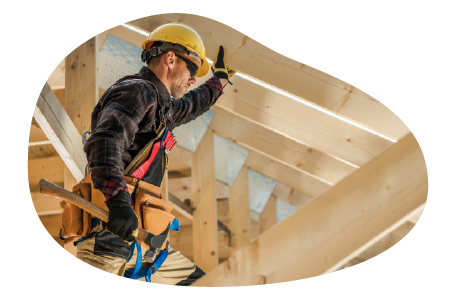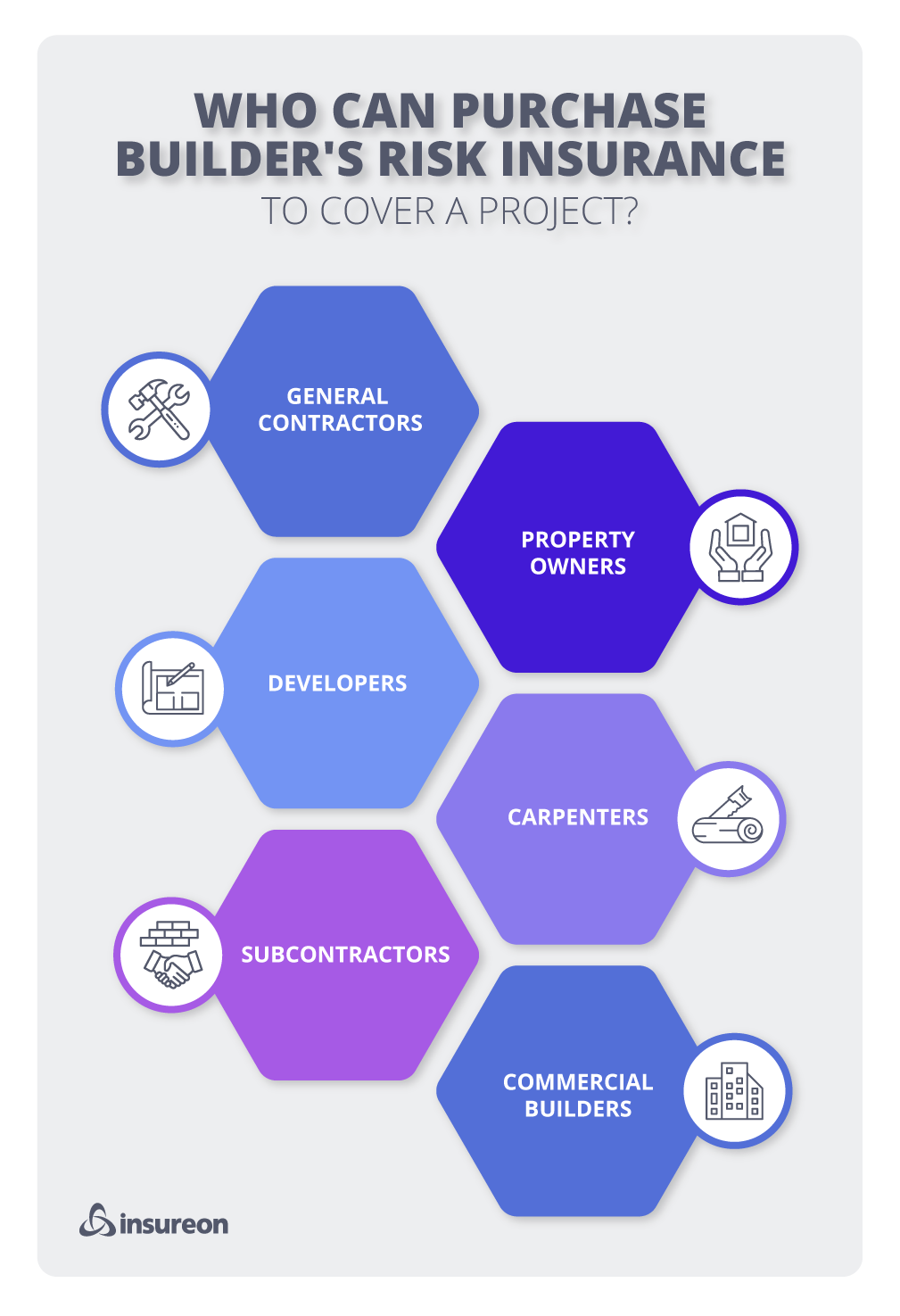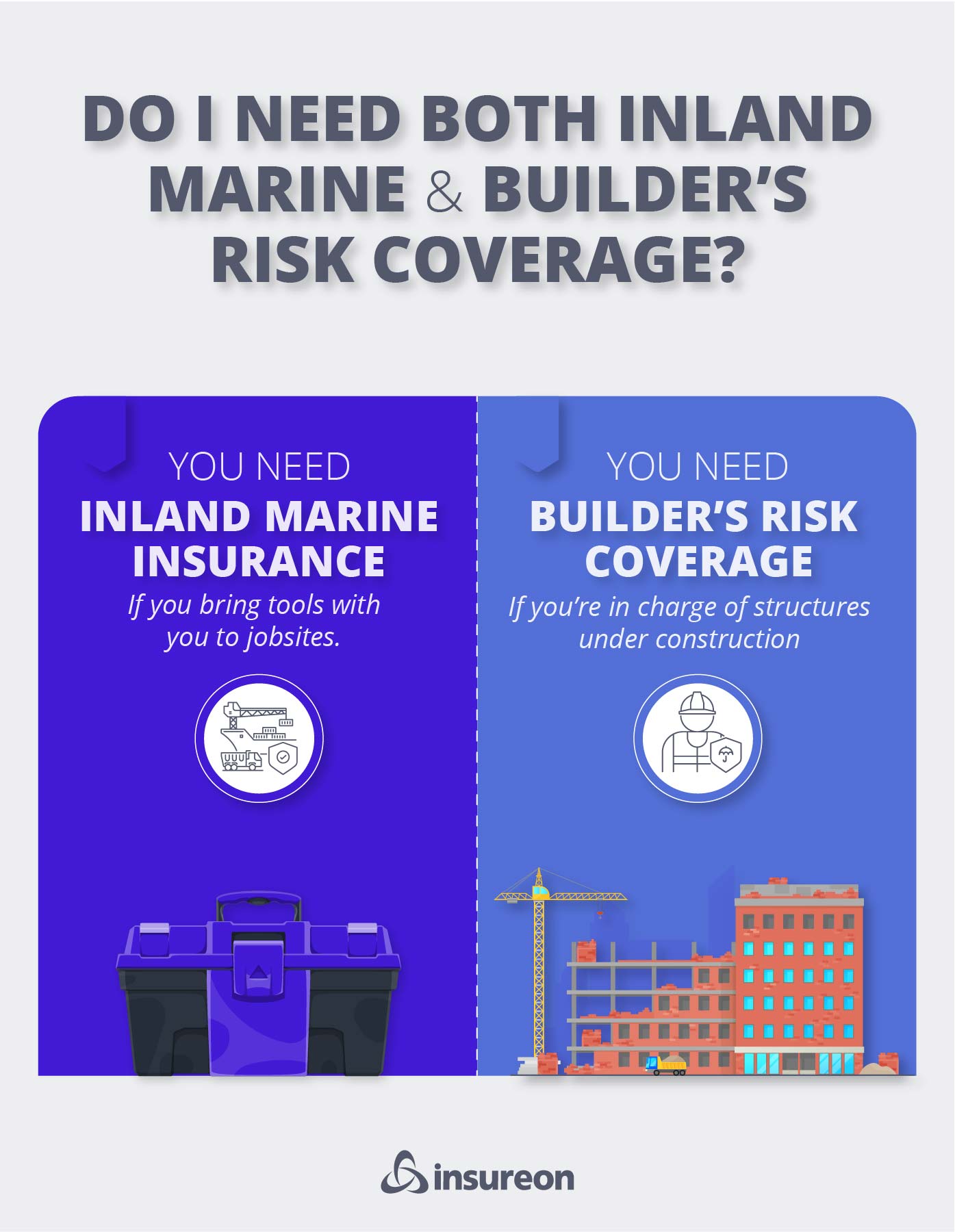
Builder’s risk insurance
Builder's risk insurance
Builder's risk insurance is also called course of construction insurance. It provides coverage for structures under construction for damages related to fire, theft, vandalism, and other risks.
Why is builder's risk insurance important?
A builder's risk insurance policy covers damage to a construction project caused by non-severe weather events, fire, vandalism, or theft. If an unexpected event harms the structure or materials on your construction site, this insurance coverage pays for the repairs or replacements needed to get the project back on track.
Because of this protection, builder's risk insurance is a key policy in the construction industry. In fact, your clients might request that you carry this policy before you begin work, or it may be required by local building codes.
Any business owner with a financial interest in the project should secure this coverage. In some cases, the homeowner may buy this coverage and add you to their policy as an additional insured.
If you rely on lenders to finance a construction project, they might require you to have this coverage, and to be listed on your policy as a loss payee.

Benefits of builder's risk coverage:
- Protect a structure in progress
- Protect temporary structures
- Safeguard construction materials
- Fulfill client requirements
- Comply with local and state building codes
What does builder's risk insurance cover?
Builder's risk insurance covers a structure in progress during its construction, as well as materials. This business insurance policy will pay for repairs and debris removal in the event of a fire, or the cost of replacing lumber stolen from a worksite. Specifically, builder's risk insurance provides coverage for:
Structural damage from weather
Builder’s risk insurance covers the cost of damage caused by non-severe weather events, such as wind, rain, and hail.
Fire damage
A fire at a construction site could severely damage building materials or an unfinished structure. Builder’s risk insurance covers the cost of replacing or repairing items damaged by fire.
Vandalism
A vandal could set a construction project back months by breaking windows, destroying fixtures, and spray painting walls. If your construction site is vandalized, builder’s risk insurance can reimburse you for the cost of repairing the damage.
On-site theft
Because construction sites are often left unguarded, they are a common target for thieves. Builder’s risk insurance can compensate you for stolen materials.
How much does builder's risk insurance cost?

Insureon's small business customers pay an average of $105 per month for this policy. The cost of builder’s risk insurance depends on the total completed value of the structure.
Other relevant factors include:
- Materials
- Labor
- Number of employees
- Coverage options, such as all-risk or named perils
- Deductible and coverage limits
What our customers are saying
Who needs builder's risk insurance coverage?
Construction companies and contractors should invest in builder's risk insurance while they are building or renovating a house, garage, office, or other structure. Anyone with a financial stake in the project, from the homeowner to the building designer, should carry this coverage.
This insurance policy can keep your company financially stable while you recover from the aftereffects of a storm or fire. It's strongly recommended for all construction projects, especially in areas where theft and vandalism are major risks. For some contracts, it may be required.
You might also need additional coverage. For example, general liability is often the first policy that most small business owners purchase. Depending on the type of work you do, you might also need professional liability coverage, or profession specific coverage such as contractors all risks insurance.
General contractors
General contractors take on big projects, which can come with big risks. An incident that destroys your hard work could also bankrupt your construction business.
For example, a fire sweeps through a construction site, scorching the siding of an unfinished building. To replace the siding, the general contractor makes a claim on their builder’s risk policy and is reimbursed for the cost of repairs.
Carpenters
Carpenters who are building new structures such as garages, sheds, and homes should invest in builder's risk insurance to protect the structure and their materials.
For example, freezing rain could damage the lumber stored at a construction site. The carpenter is responsible for replacing it, so they can turn to their builder’s risk insurance to cover the cost.
Electricians
Electricians working on new homes and offices should consider investing in builder's risk insurance.
For example, a thief breaks into a construction site and makes off with thousands of dollars' worth of copper wire. The electrician uses builder’s risk insurance to cover the cost of replacing the stolen wire.
Architects
Because they could find themselves financially responsible for damages, architects should secure builder's risk insurance during the construction of any structure they designed.
Engineers
Engineers who are involved in the structure's design and construction should also be covered by builder's risk insurance while the work takes place. If a fire or other incident occurs, the policy will pay for any damages that could be passed along to the engineer.
Top professions that need builder's risk insurance
Don't see your profession? Don't worry. We insure most businesses.

What does builder's risk insurance not cover?
While builder's risk insurance provides crucial protection for structures in progress, it does not cover every risk. For example, you'll still need general liability insurance to protect against accidents that injure someone or damage their property, along with commercial auto insurance for any vehicles owned by your business.
Common exclusions for builder’s risk insurance include:
Damage from natural disasters
Builder’s risk insurance doesn’t usually cover damage caused by natural disasters like floods, earthquakes, and tornadoes. To cover these types of events, add a severe weather endorsement to your policy.
Damage to tools and equipment
Damage to tools and equipment is not usually covered by builder's risk insurance.
Contractor’s tools and equipment insurance helps pay to repair or replace lost, stolen, or damaged tools and equipment valued under $10,000. You may also see it called equipment floater insurance.
Damage due to faulty design or poor materials
Builder’s risk insurance doesn’t cover damage to an unfinished structure that results from faulty design, negligent construction, or material defects. Professional liability insurance for construction workers and contractors helps protect your business from these liabilities.
Employee injuries
Builder’s risk insurance does not protect employees from injuries or illnesses related to work on a construction site. Workers’ compensation insurance helps pay medical costs and partial lost wages resulting from work injuries and occupational illnesses.
Other important policies for small businesses that purchase builder's risk insurance
Builder's risk insurance covers structures under construction, but it doesn’t protect against many other types of business risks. Construction and contracting business owners should also consider:
General liability insurance: This policy can cover expenses related to client injuries and damage to a customer’s property.
Business owner's policy: A BOP bundles general liability coverage and commercial property insurance at a discount. It protects against the most common lawsuits and property damage.
Workers’ compensation insurance: Workers’ comp covers medical costs for work-related injuries and illnesses. Most states require this coverage for businesses with employees.
Professional liability insurance: This policy covers professional mistakes and oversights, such as a contractor missing a project deadline.
Surety bonds: These bonds reimburse your clients for financial losses if your company is unable to fulfill the terms of its contract. They may be required to qualify for contracts or obtain a construction permit.
Contractor’s tools and equipment insurance: Covers the cost of repairing or replacing your tools and equipment if they’re lost, stolen, or damaged. This typically applies to equipment that is less than five years old.

FAQs about builder's risk insurance
How does builder's risk insurance work?
Builder’s risk insurance is a type of commercial property insurance that lasts only for the duration of a construction project. The policy usually goes into effect before the first building materials arrive at the job site, and coverage ends as soon as the project is complete.
Depending on the insurance company, this coverage may be added as an endorsement or purchased as a standalone policy. The policy can cover an existing building under renovation or new construction.
Who typically provides builder's risk insurance?
You might wonder who is responsible for builder's risk insurance. Usually, it's the contractor, the property owner, or the developer who buys the policy.
In fact, anyone with a financial stake in a construction project can purchase a builder’s risk policy to protect their investment from theft and property damage. That includes general contractors, carpenters, subcontractors, building owners, and commercial builders.
If the property owner or developer buys the policy, contractors or subcontractors may want to make sure they are listed as a named insured. You may need to have a discussion with all involved parties to clarify who is responsible for buying the policy and who is listed on it.
This type of insurance is usually more important for contractors than property owners, since courts typically hold contractors liable for construction site damage.
What's the difference between builder's risk and course of construction insurance?
Builder's risk insurance and course of construction insurance refer to the same coverage. The only difference is what the insurance company chooses to call the policy.
However, there are differences in what your insurance company might include in your policy. With some policies, you may need to add inland marine insurance to cover items in transit or stored off-site, such as tools and equipment or materials.
Other builder's risk policies might include this protection. When you buy a policy, confirm with your insurance agent what it does and does not include. They can help you secure any additional coverage you might need.

What is the difference between builder's risk and liability insurance?
Builder's risk insurance is a type of property insurance, which is different from liability insurance. Property insurance protects against costs related to stolen or damaged property, while liability insurance protects against costs related to lawsuits.
There are several kinds of liability insurance that cover different risks. The most common is general liability insurance, which covers customer injuries, accidental damage to a customer's property, and advertising injuries. Another important liability policy is professional liability insurance, which pays for your legal costs if a customer accuses your business of professional negligence.
Your business's unique risks determine which policies you might need. An insurance agent can help you find the best coverage for your small business.
























